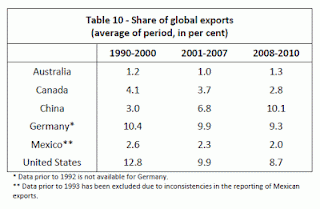Bank of Canada researchers recently published an interesting paper tilted the Evolution of Canada's Global Export Market Share.
One's gut reaction is to assume that with the commodities boom of the last decade, Canada's export share would have dramatically risen. We are, after all, hewers of wood and drawers of water, and the stuff we sell is generally more expensive.
Not so. I've cribbed a few charts and tables from the paper:
Since 2001, Canada has experienced some of the fastest growing costs when it comes to manufacturing. As a result, it's tough to justify building, let alone maintaining, export capacity in Canada's manufacturing regions.
If labour and other costs weren't sticky, we wouldn't be seeing this effect. Rather, the nominal rise in the Canadian dollar of the past ten years would be perfectly offset by local wage cuts, ensuring that real costs stayed constant. But we don't live in that world. That's why monetary policy has bite, and why devaluations are effective.
One's gut reaction is to assume that with the commodities boom of the last decade, Canada's export share would have dramatically risen. We are, after all, hewers of wood and drawers of water, and the stuff we sell is generally more expensive.
Not so. I've cribbed a few charts and tables from the paper:
As the table shows, Canada's share of global exports has steadily declined since 1990 from 4.1% to 2.8%, despite oil prices being some 8x higher than before..
Why is this? The next table illustrates growth in various Canadian and world export markets:
While Canada's energy commodity exports have ballooned, look what has happened to machinery, automotive, and consumer exports since 2001. Splat. The commodity boom's influence on Canada's export share has been entirely counterbalanced by general weakness in Canadian manufacturing exports.
There are many reasons for this. Canada's rising cost structure sure hasn't helped. The following chart shows real effective exchange rates for manufacturing sectors across several countries:
If labour and other costs weren't sticky, we wouldn't be seeing this effect. Rather, the nominal rise in the Canadian dollar of the past ten years would be perfectly offset by local wage cuts, ensuring that real costs stayed constant. But we don't live in that world. That's why monetary policy has bite, and why devaluations are effective.



Comments
Post a Comment